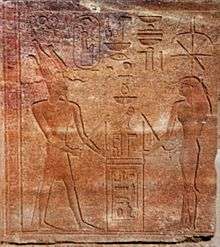Seshat's emblem
| Two variations of Seshat's emblem in hieroglyphs |
|---|
The Seshat emblem is a hieroglyph representing the goddess Seshat in Ancient Egypt. As the emblem symbolizes this deity, it sits atop her head.
Seshat emblem

In classical Ancient Egypt, the Seshat Emblem was a long stem with a 7-petal flower on top and surmounted by a pair of horns; the archaic form had 7-petals (the vertical shaft as 8), (as a vertical, with two crossed lines-(4), as a 'star', and one horizontal-(2), giving 7+ the 1-vertical shaft), and surmounted by two enclosing sickle-shaped signs, two falcon-feathers on top.
The Seshat emblem in Egyptian is the name of Seshat (sš3t). As the origin of her name is related to the male scribe, and she represents the female version, it is thought her origins also involve the stars, and ancient Egyptian astronomy.
Palermo Stone usage
_1.jpg)
The famous 24th century BC Palermo Stone has multiple uses of Seshat's emblem. It occurs on the obverse of the Palermo Piece (at Palermo Museum), 1 of the 2 large pieces of the 7—piece Palermo Stone. It is used on the obverse, Row III (of VI rows), and is used twice in King Year Record 34, and 40 of King Den. It is also used elsewhere on the stone for God Seshu,[1] the male counterpart of Seshat (Seshait or Sesha-t).[2]
The reading is approximately: "YEAR: To create (a) Statue for Seshait, Statue for Mafdet." (The King Year 34 register has the clearer of the two styles of Seshat Emblem, with larger spacing between the 2-vertical feathers. Note: the Gardiner font reads left-to-right; the Palermo Stone is written opposite: right-to-left. A large renpet (hieroglyph) for YEAR, precedes the register (forms its starting border).)
Iconographic example, Goddess Seshat
One famous example of the iconographic use of the Seshat's emblem is from Pharaoh, and Queen Hatshepsut's Red Chapel.
 Ushabti box with hieroglyphs of Seshat's emblem
Ushabti box with hieroglyphs of Seshat's emblem
See also
References
| Wikimedia Commons has media related to Seshat. |
| Wikimedia Commons has media related to Seshat's emblem. |
- Budge, 1920, (1978). An Egyptian Hieroglyphic Dictionary, E.A.Wallace Budge, (Dover Publications), c 1978, (c 1920), Dover edition, 1978. (In two volumes, 1314 pp. and cliv-(154) pp.) (softcover, ISBN 0-486-23615-3)